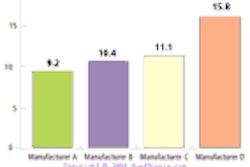(Radiology Review) Classic 2D time-of-flight magnetic resonance angiography (MRA) had a higher sensitivity and specificity for predicting 70% or greater carotid stenosis, according to radiologists who compared the modality with contrast-enhanced and multiple overlapping thin-slab acquisition (MOTSA) MR. Dr J. Kevin DeMarco and colleagues, at the University of Medicine and Dentistry of New Jersey, evaluated the clinical usefulness of classic 2D time-of-flight MRA for patients scanned because of suspected carotid stenosis. Study results were published recently in the American Journal of Roentgenology (September 2004, Vol. 183, pp. 787-793).
"Our hypothesis was that classic 2D time-of-flight MR angiography would have the 'old' sensitivity of 2D time-of-flight MRA, in which a signal void indicated a carotid stenosis of 70% or greater diameter, according to North American Symptomatic Carotid Endarterectomy Trial (NASCET) criteria," the authors wrote. Patients had been referred for MRA either because clinical symptoms suggested stroke or transient ischemic attack, or duplex Doppler scanning indicated a 70% or greater diameter stenosis.
Using a 1.5-tesla system, 68 patients (133 carotid bifurcations) had additional nonderated 2D time-of-flight MRA using a pulse sequence modified to demonstrate a carotid diameter stenosis of 70% or greater as a signal void. The additional scanning time was less than one minute. "The target gradient amplitude and slew rate for any gradient lobe between the plateau of the slice selection gradient and the plateau of the readout gradient (inclusive) were derated to 10 mtesla/m and 16.7 T/m per second, respectively."
Elliptical centric contrast-enhanced MRA was performed in all patients, and 33 also had MOTSA MRA (two or three overlapping thin slabs). Digital subtraction angiography was considered the gold standard in 51 patients, and in this group 2D time-of-flight MRA for 70% or greater stenosis showed a sensitivity of 94% and a specificity of 97%. The remaining patients' results were compared with surgical findings and duplex Doppler results.
"In three patients with severe carotid stenosis, the stenoses that appeared as signal voids on the classic 2D time-of-flight MRA were underestimated on contrast-enhanced," according to the authors. They recommended using classic 2D time-of-flight MRA in conjunction with higher-resolution MOTSA and contrast-enhanced MRA to reduce false-negative preoperative results. "Evaluating all types of stenotic carotid lesions with classic 2D time-of-flight MRA alone is not advisable because of the false-positive findings that would result."
The authors concluded that classic 2D time-of-flight MRA "increased diagnostic confidence of a severe stenosis in three patients" with severe internal carotid artery narrowing. They particularly recommended adding this mode of MRA when there was a discrepancy among duplex Doppler sonography, contrast-enhanced MRA, and MOTSA MRA.
"Evaluation of Classic 2D Time-of-Flight MR Angiography in the Depiction of Severe Carotid Stenosis"
DeMarco, J.K., et al
Laurie Imaging Center, University Radiology Group
University of Medicine and Dentistry of New Jersey
141 French Street, New Brunswick, NJ 08901 USA
AJR 2004 (September); 183:787-793
By Radiology Review
October 18, 2004
Copyright © 2004 AuntMinnie.com



















